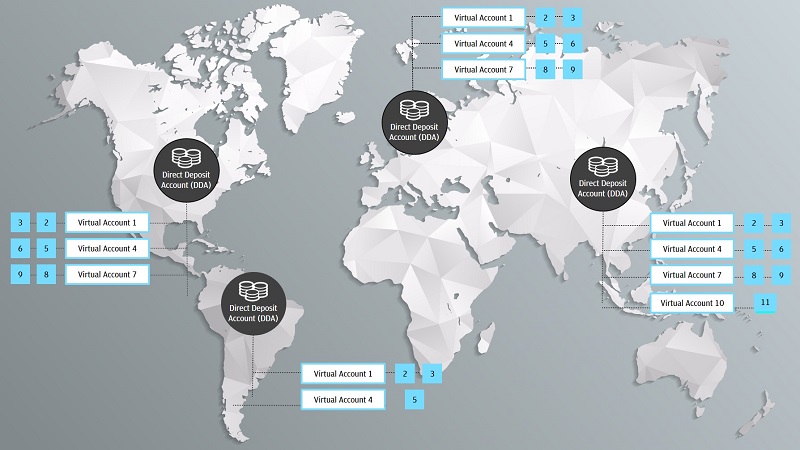Lori Schwartz, Head of Global Liquidity Product Specialists at J.P. Morgan, sat down with PYMNTS.com to discuss the impact of a digital evolution in liquidity management.
Liquidity becomes mission-critical
The need to make real-time decisions regarding cash management has never been more critical. In fact, the very nature of liquidity management is changing — and leading treasuries to pivot to modernization by moving away from physical to virtual accounts.
Any business “that operates, day to day, in moving money, taking in payments, making sure supplier payments happen, it’s extraordinarily important to know where your liquidity is,” says Lori Schwartz, Head of Global Liquidity Product Specialists at J.P. Morgan.
CFO’s and Treasurers must constantly monitor how much money is in corporate accounts, know exactly what’s available and where receivables and payables activity stands at any given time. They must also be able to reconcile those accounts and address funding requirements in a proactive, strategic manner. For executives to have that holistic insight, visibility is key.
Visibility leads to control, which enables optimization.
Lori Schwartz
Managing Director, Corporate & investment bank
However, visibility and digitization are not so simple for global corporate treasurers, given the complexity and sheer number of accounts and sometimes millions of dollars in fund flows.
“New technology is coming to the forefront to help that information exchange,” she said, noting that application programming interfaces (APIs) can give firms real-time visibility into banking activities. Not so long ago, linking cash account statements across far-flung systems or operations would have taken days or weeks and extensive testing to synthesize all that data into one centralized presentation.
The Centralization Imperative
Centralized access to information is imperative as firms navigate managing liquidity across jurisdictions and across currencies. This is where virtual accounts come in. Cash can be flexibly managed through virtual accounts, which segment, forecast and address cash positions (and set controls) across an integrated online platform.
Virtual accounts help address one of the biggest inhibitors of high-tech solutions — chiefly, the potential loss of data or information.
Virtual accounts combine the centralization of liquidity while retaining the integrity of all that underlying information. You can direct and separate different activities, entities and projects, but ultimately all of that cash is still centralized immediately and together. It’s the best of both worlds.

The centralization virtual accounts offer applies particularly well to intercompany lending, which traditionally would require a complex, manual system of comparing and contrasting individual accounts, determining excess and surplus cash positions and creating payments to address funding issues if necessary.
"You have to consider if there are cross-bank relationships in the mix, or if you need to cross-fund across currencies,” said Schwartz. “When you adapt that into a virtual account, you have that intercompany lending happening at the transaction level because all of your entities would have accounts within the virtual account structure. That funding essentially is available immediately.”
The corporate treasurer is an important part of change — and now, they can become the enabler of the products their businesses are offering.
Lori Schwartz
Managing Director, Corporate & investment bank
Schwartz said technology deployments, done thoughtfully, can take on at least some of the activities done manually by financial professionals, freeing them up to add value to their companies through insights and robust, strategic thinking.
To learn more about how treasurers are turning to virtual accounts as a key cash management tool, read "Virtual Account Management: The Future is Now"
Disclaimer
This material was prepared exclusively for the benefit and internal use of the JPMorgan client to whom it is directly addressed (including such client’s subsidiaries, the “Company”) in order to assist the Company in evaluating a possible transaction(s) and does not carry any right of disclosure to any other party. This material is for discussion purposes only and is incomplete without reference to the other briefings provided by JPMorgan. Neither this material nor any of its contents may be disclosed or used for any other purpose without the prior written consent of JPMorgan.
J.P. Morgan, JPMorgan, JPMorgan Chase and Chase are marketing names for certain businesses of JPMorgan Chase & Co. and its subsidiaries worldwide (collectively, “JPMC”). Products or services may be marketed and/or provided by commercial banks such as JPMorgan Chase Bank, N.A., securities or other non-banking affiliates or other JPMC entities. JPMC contact persons may be employees or officers of any of the foregoing entities and the terms “J.P. Morgan”, “JPMorgan”, “JPMorgan Chase” and “Chase” if and as used herein include as applicable all such employees or officers and/or entities irrespective of marketing name(s) used. Nothing in this material is a solicitation by JPMC of any product or service which would be unlawful under applicable laws or regulations.
Investments or strategies discussed herein may not be suitable for all investors. Neither JPMorgan nor any of its directors, officers, employees or agents shall incur in any responsibility or liability whatsoever to the Company or any other party with respect to the contents of any matters referred herein, or discussed as a result of, this material. This material is not intended to provide, and should not be relied on for, accounting, legal or tax advice or investment recommendations. Please consult your own tax, legal, accounting or investment advisor concerning such matters.
Not all products and services are available in all geographic areas. Eligibility for particular products and services is subject to final determination by JPMC and or its affiliates/subsidiaries. This material does not constitute a commitment by any JPMC entity to extend or arrange credit or to provide any other products or services and JPMorgan reserves the right to withdraw at any time. All services are subject to applicable laws, regulations, and applicable approvals and notifications. The Company should examine the specific restrictions and limitations under the laws of its own jurisdiction that may be applicable to the Company due to its nature or to the products and services referred herein.
Notwithstanding anything to the contrary, the statements in this material are not intended to be legally binding. Any products, services, terms or other matters described herein (other than in respect of confidentiality) are subject to the terms of separate legally binding documentation and/or are subject to change without notice.
JPMorgan Chase Bank, N.A. Member FDIC.
JPMorgan Chase Bank, N.A., organized under the laws of U.S.A. with limited liability.







